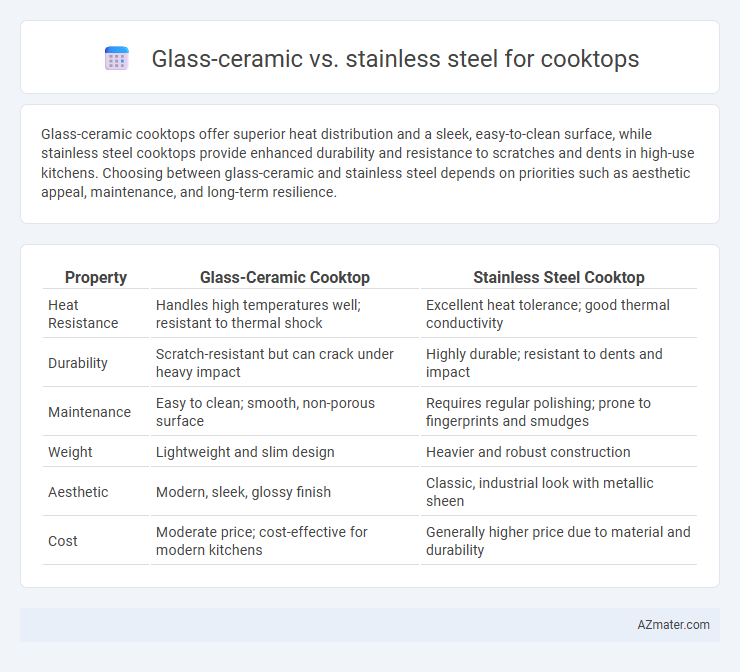Glass-ceramic cooktops offer superior heat distribution and a sleek, easy-to-clean surface, while stainless steel cooktops provide enhanced durability and resistance to scratches and dents in high-use kitchens. Choosing between glass-ceramic and stainless steel depends on priorities such as aesthetic appeal, maintenance, and long-term resilience.
Table of Comparison
| Property | Glass-Ceramic Cooktop | Stainless Steel Cooktop |
|---|---|---|
| Heat Resistance | Handles high temperatures well; resistant to thermal shock | Excellent heat tolerance; good thermal conductivity |
| Durability | Scratch-resistant but can crack under heavy impact | Highly durable; resistant to dents and impact |
| Maintenance | Easy to clean; smooth, non-porous surface | Requires regular polishing; prone to fingerprints and smudges |
| Weight | Lightweight and slim design | Heavier and robust construction |
| Aesthetic | Modern, sleek, glossy finish | Classic, industrial look with metallic sheen |
| Cost | Moderate price; cost-effective for modern kitchens | Generally higher price due to material and durability |
Introduction to Cooktop Surface Materials
Glass-ceramic cooktops feature a smooth, sleek surface made from durable, heat-resistant glass fused with ceramic materials, offering rapid heat transfer and easy cleaning. Stainless steel cooktops provide a robust, corrosion-resistant surface known for longevity and resistance to impact, often favored in commercial kitchens for its industrial aesthetic and durability. The choice between glass-ceramic and stainless steel surfaces impacts heat distribution, maintenance requirements, and overall kitchen design compatibility.
What is Glass-Ceramic Cooktop?
Glass-ceramic cooktops feature a smooth, durable surface made from a specialized glass and ceramic blend that provides excellent heat resistance and uniform heat distribution. This material allows for rapid heating and cooling, making it energy-efficient and ideal for precise cooking control. Its sleek appearance and ease of cleaning contrast with stainless steel cooktops, which offer superior durability and resistance to dents but may lack the seamless surface of glass-ceramic.
What is Stainless Steel Cooktop?
Stainless steel cooktops are kitchen surfaces made from durable, corrosion-resistant stainless steel alloy known for its strength and heat resistance. These cooktops provide a sleek, modern look while offering excellent durability and ease of cleaning, making them a popular choice for both residential and commercial kitchens. Compared to glass-ceramic cooktops, stainless steel surfaces are less prone to cracking or scratching but may require more frequent polishing to maintain their shine.
Heat Efficiency and Distribution
Glass-ceramic cooktops provide excellent heat efficiency due to their rapid heating capabilities and direct contact with cookware, minimizing energy loss. Stainless steel cooktops, while durable, often exhibit uneven heat distribution because metal surfaces conduct heat less uniformly compared to glass-ceramic surfaces. The superior thermal conductivity of glass-ceramic materials ensures consistent cooking temperatures and energy savings over stainless steel options.
Durability and Scratch Resistance
Glass-ceramic cooktops offer a sleek, smooth surface with moderate scratch resistance but are prone to cracking or chipping under heavy impact due to their brittle nature. Stainless steel cooktops provide superior durability with excellent resistance to dents, cracks, and scratches, making them ideal for heavy-use environments. The corrosion-resistant properties of stainless steel further enhance its longevity compared to the more delicate glass-ceramic surfaces.
Ease of Cleaning and Maintenance
Glass-ceramic cooktops offer a smooth, flat surface that makes wiping away spills and stains quicker and easier, reducing the need for abrasive scrubbing. Stainless steel cooktops, while durable and resistant to heat, often show fingerprints and streaks, requiring frequent polishing to maintain their appearance. Regular maintenance for glass-ceramic involves avoiding harsh cleaners to prevent scratches, whereas stainless steel demands consistent use of stainless steel-specific cleaning products to prevent water spots and corrosion.
Aesthetic Appeal and Kitchen Design
Glass-ceramic cooktops offer a sleek, modern aesthetic with a smooth, glossy surface that seamlessly integrates into contemporary kitchen designs, enhancing visual appeal through minimalistic and clean lines. Stainless steel cooktops provide a timeless, industrial look that complements both traditional and modern kitchens, offering durability and a polished finish that resists stains and scratches. The choice between glass-ceramic and stainless steel significantly influences kitchen ambiance and style cohesion, with glass-ceramic emphasizing elegance and sophistication, while stainless steel highlights practicality and robustness.
Cost Comparison: Glass-Ceramic vs Stainless Steel
Glass-ceramic cooktops typically cost between $300 and $1,500, offering a sleek, modern appearance and efficient heat distribution, while stainless steel cooktops range from $250 to $1,200, known for durability and resistance to corrosion. Glass-ceramic models may incur higher maintenance and repair costs due to their fragile surface, whereas stainless steel surfaces are easier to clean and maintain, potentially saving on long-term upkeep expenses. Consumers seeking cost-effective options often favor stainless steel for initial investment and durability, whereas glass-ceramic appeals to those prioritizing aesthetics despite potentially higher replacement costs.
Safety Features and Considerations
Glass-ceramic cooktops offer smooth surfaces with heat-resistant properties that reduce the risk of burns and are easier to clean, minimizing the chance of food residue causing flare-ups. Stainless steel cooktops provide superior durability, resistance to dents and scratches, and often feature reinforced edges to prevent injuries during cooking. Both materials incorporate safety features such as automatic shut-off sensors and cool-touch zones, but glass-ceramic surfaces are more prone to cracking under impact, while stainless steel models emphasize structural resilience.
Which Cooktop is Best for Your Needs?
Glass-ceramic cooktops offer a sleek, smooth surface that heats quickly and provides precise temperature control, making them ideal for those who prioritize aesthetics and easy cleaning. Stainless steel cooktops are highly durable, resistant to dents and scratches, and better suited for high-heat cooking, appealing to users who value robustness and longevity. Choosing between glass-ceramic and stainless steel depends on whether you prioritize modern design and ease of maintenance or rugged durability and heavy-duty performance.

Infographic: Glass-ceramic vs Stainless steel for Cooktop
 azmater.com
azmater.com